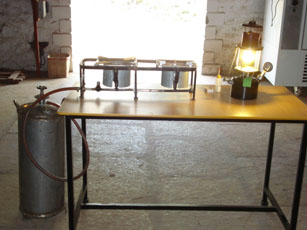
Ethanol Stoves and Lanterns
 Liquid and gaseous fuels are inherently clean household fuels. Moreover due to their high energy density, easy transportability, easy storage and local availability, the liquid fuels are superior to other renewable alternatives like biogas, wood and other biomass resources.
NARI has therefore developed complete technology for running cooking stoves and lanterns on low concentration [55-60% (w/w)] ethanol-water mixture.
Liquid and gaseous fuels are inherently clean household fuels. Moreover due to their high energy density, easy transportability, easy storage and local availability, the liquid fuels are superior to other renewable alternatives like biogas, wood and other biomass resources.
NARI has therefore developed complete technology for running cooking stoves and lanterns on low concentration [55-60% (w/w)] ethanol-water mixture. The main reason for choice for this mixture is as follows :
- The low grade ethanol-water mixture is less flammable than pure ethanol, making it safe to handle and hence ideal for household cooking purposes. It burns very cleanly and hence is environmentally friendly.
- The mixture is easy to distil and can be produced in a one-step distillation process even using solar energy as the driving force, thus reducing the energy utilized in its production and hence the overall cost of fuel.
- In rural areas of developing countries, a substantial amount of illicit liquor production takes place in makeshift backyard and rudimentary distillation units, which produce alcohol with 45-60% (w/w) ethanol-water concentration. This alcohol is mainly used for drinking. The use of this as fuel in the ethanol stove and lanterns can hopefully help solve both the problems of drinking and rural household fuel.
The specifications of the stove are :
| Item | Specification |
| Design stove capacity | 0.9 to 2.45 kW (or turn-down ratio of 1:2.7) |
| Efficiency | 44 to 46% |
| Design fuel composition | 50-60% (w/w) ethanol water mixture |
| Tested fuel composition | 38 to 95% (w/w) ethanol in the mixture |
| Minimum fuel composition that can be used in the stove | 45% (w/w) ethanol in the mixture |
| Fuel tank capacity | 2.6 l |
| Fuel tank operating pressure | 50-150 kPa |
| Overall dimensions | 42 X 19 X 21 cm |
| Weight | 4.6 kg (empty) and 6.9 kg (full with fuel) |
| Construction materials | Mainly stainless steel (around 70%) and mild steel |
| Estimated mass production cost | Rs. 1500 per stove |
The stove is completely silent and runs like an LPG one. The details are given here.
Similarly it was also felt necessary to develop an efficient lantern running on a low concentration ethanol so that the same fuel stream could be used for both cooking and lighting.
The specifications of lantern are :
| Item | Specification |
| Lantern | Pressurized with rare earth oxide mantle |
| Pressure | 0.60-0.90 kg/cm2 (g) |
| Light Output | 1100-1400 lumens |
| Light Efficacy | 1.0-1.2 lm/W |
| Fuel Used | 55-60% (w/w) ethanol-water mixture |
| Fuel Consumption | 250-275 g/hr (58% ethanol-water) |
| Power Consumption | 1080-1185 W |
| Fuel tank capacity | 1.1 liters |
| Weight of lantern | 3.5 kg (with full fuel) 2.4 kg (without fuel) |
| Dimensions of lantern | 37 cm (H) 23 cm (D) |
| Sound level | 55-58 dB (existing Petromax lanterns 65-75 dB) |
| Construction materials | Mild steel, Stainless steel, Teflon and other high performance plastics |
| Est. mass production cost | Rs. 1,000 per lantern (production of >10,000 pieces/year) |
NARI has also developed the technology where a pre-compressed cylinder of ethanol fuel is attached to the stove and lantern for continuous running. This is just like an LPG cylinder and both the lantern (a YouTube video) and stove starts with the flip of a valve. This will also help tremendously in curbing the consumption of alcohol for drinking purposes.
Besides the ethanol lantern with cylinder also doubles up as a cooking stove (a YouTube video). A newly developed Janta cooker which works on the heat pipe principle can cook all the food for a family of four. Thus this is a unique lantern where it not only provides light but also cooks the complete meal for the family simultaneously. Thus both cooking and lighting functions for a family can be met by this lantern. This pioneering device can alleviate the problems of household energy for rural areas.

Alcohol dual burner stove with 15-20 days' fuel supply.
 Ethanol lantern with fuel storage and Janta cooker
Ethanol lantern with fuel storage and Janta cooker
 Movable alcohol lantern.
Movable alcohol lantern.
